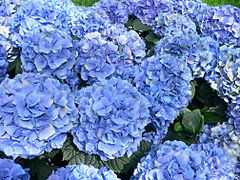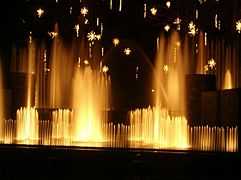Longwood Gardens

Longwood Gardens consists of over 1,077 acres (4.2 km²) of gardens, woodlands, and meadows in Kennett Square, Pennsylvania, United States in the Brandywine Creek Valley.[1] It is one of the premier botanical gardens in the United States and is open to visitors year-round to enjoy exotic plants and horticulture (both indoor and outdoor), events and performances, seasonal and themed attractions, as well as take part in educational lectures, courses, and workshops.
History
Longwood Gardens has had a long and varied history. For thousands of years, the native Lenni Lenape tribe fished its streams, hunted its forests, and planted its fields. Evidence of tribe's existence is found in quartz spear points that have been discovered on and around the property, and can be found on display in the Peirce-du Pont House on the Longwood Gardens property.
In 1700, a Quaker farmer named George Peirce purchased 402 acres of this English-claimed land from William Penn’s commissioners. George’s son Joshua cleared and farmed the land and in 1730 he built the brick farmhouse that, enlarged, still stands today.
In 1798, Joshua’s twin grandsons Samuel and Joshua, who had inherited the farm, actively pursued an interest in natural history and began planting an arboretum that eventually covered 15 acres. The collection included specimens that they collected from the wild as well as plants acquired from some of the region’s leading botanists.
By 1850, the arboretum boasted one of the finest collections of trees in the nation and had become a place for the locals to gather outdoors – a new concept that was sweeping America at the time. Community picnics and socials were held at Peirce's Park in the mid to late 19th century.
As the 19th century rolled into the 20th, the family’s heirs lost interest in the property and allowed the arboretum to deteriorate. The farm passed out of the family through several hands in quick succession, and a lumber mill operator was about the cut down the trees for timber in early 1906. It was this threat that moved one man to take action.
On July 20, 1906, 36-year-old Pierre du Pont purchased the farm primarily to preserve the trees. He wasn’t planning to create Longwood Gardens, but within a few years, his desire to make it a place where he could entertain his friends transformed a simple country farm into one of the country’s leading horticultural display gardens. [2]
Longwood today
Today the 1,077-plus acre Longwood Gardens consists of 20 outdoor gardens and 20 indoor gardens within 4.5 acres (18,200 m²) of heated greenhouses, known as conservatories.[3][4][5] It contains 11,000 different types of plants and trees, as well as fountains. The Gardens also has extensive educational programs including a tuition-free two-year school of professional horticulture,[6] a graduate program, and extensive internships. It hosts 800 horticultural and performing arts events each year, from flower shows, gardening demonstrations, courses, and children's programs to concerts, organ and carillon recitals, musical theatre, fountain shows, and fireworks displays. It also hosts an extensive Christmas light display during the holiday season.
Longwood's conservatory is one of the world's greatest greenhouse structures. The conservatory alone is home to 5,500 types of plants. An exploration of the 20 indoor gardens spanning a half mile takes about an hour and a half. Gardens of the conservatory, each with its own exquisite displays of plants, include The Orangery, Silver Garden, Acacia Passage, Orchid House, Cascade Garden, Palm House, Mediterranean Garden, Tropical Terrace and the Outdoor Water Garden display. Since its original construction date in 1919, it has undergone expansions and renovations.[7] In January 2003, the East Conservatory was closed for a renovation project, with the main hall reopening to the public on October 29, 2005.[8]
The gardens attracted nearly 900,000 visitors during 2009 and plans for the growth and expansion of Longwood Gardens for the next four decades began in 2010 with the hiring of West 8, a Dutch landscape architecture and urban planning firm with headquarters in Rotterdam and an office in New York City. The founder of West 8, Adriaan Geuze, stated their mission is: "to celebrate Longwood, enjoy it, keep it, preserve it, while asking how could it function as a spectacular place for larger groups of people in the 21st century." The comprehensive Longwood plan is expected to be complete by July 2011.[9]
Organ
The resident Longwood Organ is a 10,010 pipe instrument designed by Longwood organist-in-residence Firmin Swinnen, a Belgian musician who moved to the US in 1916 and became a prominent theater organist in New York City.[10] The organ's pipes filled fourteen railway freight cars, and they needed a 72 horsepower (54 kW) blower motor to supply the wind pressure; the instrument was one of the largest pipe organs installed in a private residence. Pierre du Pont ordered a massive Aeolian organ in 1929 to replace the previous organ of 3,650 pipes, which he donated to the University of Delaware where it stayed until 1964.[11] The four-manual organ plays into the Longwood ballroom and can be heard throughout the conservatory when adjoining window panels are opened. Its pipes may be viewed from the rear through glass panels in Longwood's organ museum. The Longwood Organ has recently undergone a restoration that began in 2004 and was completed in January 2011.[12]
Gallery
-
Chimes Tower in Longwood Gardens
-
Chimes Tower in Longwood Gardens
-
Main Fountains at Longwood Gardens
-

East Conservatory, Longwood Gardens
-
Indoor Conservatory
-
Different view of Italian Water Garden
-
Indoor hall, November 2012
-
Exterior walkway, November 2012
-

Peirce-Du Pont House, currently a museum
-

One of the many orchids from the Longwood Gardens' greenhouse
-

More samples of orchids from the Longwood Gardens' greenhouse
-
More samples of orchids from the Longwood Gardens' greenhouse
-
More samples of orchids from the Longwood Gardens' greenhouse
-

Hydrangeas from the gardens
-

Longwood Gardens fountain night display, 2006
-

Longwood Gardens railway display, 2010
-

Longwood Gardens pumpkins and gourds, 2010
-

Longwood Gardens Bird of Paradise, 2010
-
One-Thousand Bloom Display, November 2012
See also
| Wikimedia Commons has media related to Longwood Gardens. |
- List of botanical gardens in the United States
- List of museums in Pennsylvania
- Cannas at Longwood Gardens
- Winterthur Museum
- Nemours Mansion and Gardens
- Hagley Museum and Library
References
- ↑ "Longwood Gardens". InUSA.com. Retrieved April 29, 2008.
- ↑ Longwood Gardens: 100+ Years of Garden Splendor
- ↑ "Longwood Gardens Celebrating its centennial with every new bud". Bedford Gazette. Associated Press. 2006-02-22. p. 14.
- ↑ "A Longwood Gardens Christmas Never Disappoints". Washington Examiner. 2009-11-29.
- ↑ "The Gardens - Explore Longwood". Longwood Gardens. Retrieved January 21, 2010.
- ↑ "Professional Gardener Training Program". Longwood Gardens. Archived from the original on 2006-12-22.
- ↑ "The Conservatory." Longwood Gardens. Retrieved on 2010-02-25.
- ↑ "Renovated Longwood conservatory awash in color". Reading Eagle. 2005-10-27. p. 35.
- ↑ "Dutch firm hopes to help Longwood grow". Philadelphia Inquirer. 2010-05-11.
- ↑ "Complete Plans For Dedication Of Organ At Local Cathedral". New Castle News. 1927-10-01. p. 1.
- ↑ "The Gardens - Organ & Carillon History". Longwood Gardens. Retrieved April 7, 2008.
- ↑ "Organ History". Longwood Gardens. Retrieved 2013-09-23.









